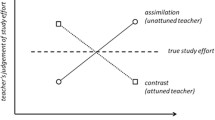Abstract
Researchers of social networks commonly distinguish between “behavioral” and “cognitive” social structure. In a school context, for example, a teacher’s perceptions of student friendship ties, not necessarily actual friendship relations, may influence teacher behavior. Revisiting early work in the field of sociometry, this study assesses the level of agreement between teacher perceptions and student reports of within-classroom friendship ties. Using data from one middle school teacher and four classes of students, the study explores new ground by assessing agreement over time and across classroom social contexts, with the teacher-perceiver held constant. While the teacher’s perceptions and students’ reports were statistically similar, 11–29% of possible ties did not match. In particular, students reported significantly more reciprocated friendship ties than the teacher perceived. Interestingly, the observed level of agreement varied across classes and generally increased over time. This study further demonstrates that significant error can be introduced by conflating teacher perceptions and student reports. Findings reinforce the importance of treating behavioral and cognitive classroom friendship networks as distinct, and analyzing social structure data that are carefully aligned with the social process hypothesized.
Similar content being viewed by others
References
Bonney M.E. (1943). The constancy of sociometric scores and their relationship to teacher judgments of social success, and to personality self-ratings. Sociometry 6, 409–424
Bonney M.E. (1947). Sociometric study of agreement between teacher judgments and student choices. Sociometry10, 133–146
Borgatti S.P., Everett M.G., Freeman L. (2002). Ucinet 6.0 for Windows. Natick,Analytic Technologies
Cairns R.B., Leung M.C., Buchanan L., Cairns B.D. (1995). Friendships and social networks in childhood and adolescence: Fluidity, reliability, and interrelations. Child Development 66, 1330–1345
Casciaro T. (1998). Seeing things clearly: Social structure, personality and accuracy in social network perception. Social Networks 20, 331–351
Durland, M., & Fredericks, K. A. (Eds.). (2005). The use of network analysis in program evaluation: Trends, techniques, and applications. New Directions in Program Evaluation, 107. San Francisco: Jossey Bass.
Freeman L.C. (1977). A set of measures of centrality based on betweeness. Sociometry 40, 35–41
Gage, N. L., Leavitt, G. S., & Stone, G. C. (1955). Teachers’ understanding of their pupils and pupils’ ratings of their teachers. Psychological Monographs No. 106. Washington, DC: American Psychological Association.
Gest S.D. (2006). Teacher reports of children’s friendships and social groups: Agreement with peer reports and implications for studying peer similarity. Social Development 15, 248–259
Gronlund, N. E. (1951). The accuracy of teachers’ judgments concerning the sociometric status of sixth-grade pupils, Sociometry Monographs, No. 25. New York: Beacon House.
Gronlund N.E. (1955). Social perception and teaching effectiveness. The School Review 63, 277–283
Gronlund N.E. (1957). The general ability to judge sociometric status: Elementary student teachers’ sociometric perceptions of classmates and pupils. The Journal of Educational Psychology 47, 147–157
Gronlund N.E. (1959). Sociometry in the classroom. New York, Harper & Brothers
Gronlund N.E., Whitney A.P. (1958). The Relation between teachers’ judgments of pupils’ sociometric status and intelligence. The Elementary School Journal 58, 264–268
Hallinan M.T., Smith S.S. (1989). Classroom characteristics and student friendship cliques. Social Forces 67, 898–919
Kilduff M., Krackhardt D. (1994). Bringing the individual back in: A structural analysis of the internal market for reputation in organizations. The Academy of Management Journal 37, 87–108
Krackhardt D. (1987). Cognitive social structures. Social Networks 9, 109–134
McFarland D.A. (2001). Student resistance: How the formal and informal organization of classrooms facilitate everyday forms of student defiance. American Journal of Sociology 107, 612–678
Moreno J.L. (1934). Who shall survive?. Washington, Nervous and Mental Disease Publishing Co.
Pearl R., Leung M.-C., Van Acker R., Farmer T.W., Rodkin P.C. (2007). Fourth- and fifth-grade teachers’ awareness of their classrooms’ social networks. Elementary School Journal 108, 25–39
Snijders T.A.B., Borgatti S.P. (1999). Non-parametric standard errors and tests for network statistics. Connections 22, 61–70
Takei Y., Johnson M.P., Clark M.E. (1998). Academic achievement and impression management as factors in the grading of white junior high pupils. Sociological Perspectives 41, 27–48
White H.C., Boorman S.A., Breiger R.L. (1976). Social structure from multiple networks. I: Blockmodels of roles and positions. American Journal of Sociology 81, 730–778
Author information
Authors and Affiliations
Corresponding author
Additional information
An earlier version of this manuscript was presented at the American Education Research Association’s Annual Meeting, April, 2007, Chicago, USA.
Rights and permissions
About this article
Cite this article
Pittinsky, M., Carolan, B.V. Behavioral versus cognitive classroom friendship networks. Soc Psychol Educ 11, 133–147 (2008). https://doi.org/10.1007/s11218-007-9046-7
Received:
Accepted:
Published:
Issue Date:
DOI: https://doi.org/10.1007/s11218-007-9046-7




